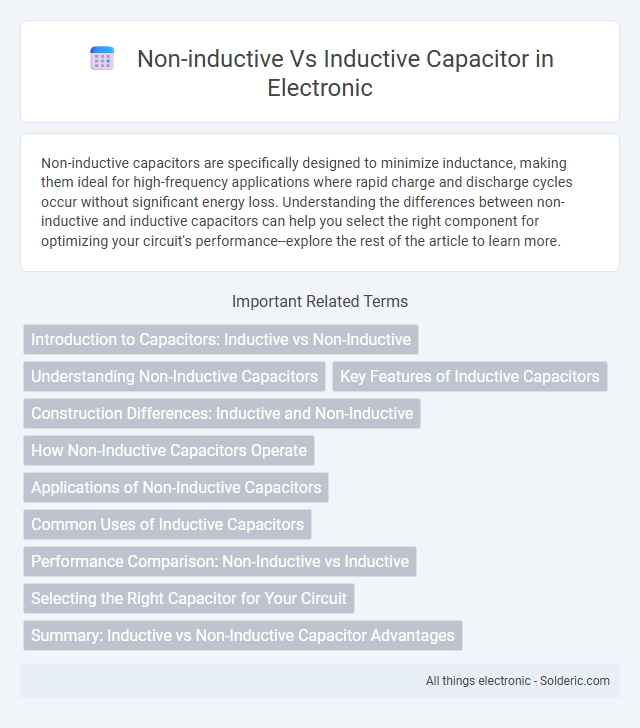Non-inductive capacitors are specifically designed to minimize inductance, making them ideal for high-frequency applications where rapid charge and discharge cycles occur without significant energy loss. Understanding the differences between non-inductive and inductive capacitors can help you select the right component for optimizing your circuit's performance--explore the rest of the article to learn more.
Comparison Table
| Feature | Non-Inductive Capacitor | Inductive Capacitor |
|---|---|---|
| Definition | Capacitor designed to minimize inductance | Capacitor with inherent or added inductance |
| Equivalent Series Inductance (ESL) | Very low ESL | Higher ESL |
| Frequency Performance | Optimized for high-frequency applications | Limited at high frequency due to inductance |
| Construction | Parallel or bifilar winding to cancel inductance | Standard winding or design with coil inductance |
| Applications | RF circuits, high-speed switching power supplies | Low-frequency filters, general-purpose circuits |
| Cost | Usually higher due to complex design | Generally lower cost |
Introduction to Capacitors: Inductive vs Non-Inductive
Non-inductive capacitors feature winding techniques or materials that minimize inductance, making them ideal for high-frequency applications where signal integrity is crucial. Inductive capacitors, often standard types, have inherent inductance due to coil-like internal structures, which can cause unwanted reactance in RF circuits. Understanding the differences ensures your circuit design meets performance goals by choosing non-inductive types to reduce interference and inductive types when inductance plays a beneficial role.
Understanding Non-Inductive Capacitors
Non-inductive capacitors are designed to minimize inductance by arranging internal elements so opposing magnetic fields cancel out, making them ideal for high-frequency applications where reducing reactive impedance is critical. Unlike inductive capacitors, which inherently possess coil-like structures causing increased inductance, non-inductive capacitors maintain stable performance in circuits requiring precise timing and filtering. Understanding non-inductive capacitors helps you select components that enhance signal integrity and reduce unwanted resonances in your electronic designs.
Key Features of Inductive Capacitors
Inductive capacitors, often used in high-frequency applications, feature an inherent series inductance due to their coil windings or lead configurations, which impacts their impedance characteristics. These capacitors are designed to handle higher currents and voltages, making them suitable for power factor correction and harmonic filtering in industrial settings. Their key distinction from non-inductive capacitors lies in the significant inductive reactance that affects their performance in resonant circuits and frequency-sensitive applications.
Construction Differences: Inductive and Non-Inductive
Inductive capacitors typically consist of coiled or spiral wound plates that create a magnetic field, introducing parasitic inductance, whereas non-inductive capacitors use bifilar winding or special configurations to cancel out inductive effects. The construction of non-inductive capacitors involves placing conductive elements in opposite directions to negate inductance, resulting in minimal self-inductance and improved high-frequency performance. Inductive types are simpler but less suited for high-frequency circuits, while non-inductive capacitors are designed for precision and stability in RF and pulse applications.
How Non-Inductive Capacitors Operate
Non-inductive capacitors operate by minimizing or eliminating the inductive reactance typically caused by the loop currents within capacitor leads and internal structure. They achieve this through a symmetrical or bifilar winding of the capacitor plates, which cancels out magnetic fields and reduces parasitic inductance. This design ensures high-frequency performance with minimal inductive distortion, making them ideal for high-frequency and precision applications.
Applications of Non-Inductive Capacitors
Non-inductive capacitors are essential in high-frequency circuits and RF applications where minimizing inductance is critical to ensure signal integrity and reduce electromagnetic interference. These capacitors are used extensively in precision filtering, pulse circuits, and high-speed digital systems to maintain stable performance under rapid voltage changes. Your designs benefit from non-inductive capacitors when accurate and reliable operation at high frequencies is required, contrasting with inductive capacitors used more commonly in low-frequency or power applications.
Common Uses of Inductive Capacitors
Inductive capacitors, often integrated with inductors to form LC circuits, are commonly used in tuning and filtering applications within radio frequency (RF) and communication systems. These capacitors exhibit minimal parasitic inductance, making them ideal for high-frequency signal processing and resonance circuits. Their precise impedance characteristics enable efficient frequency selection in oscillators and signal modulators.
Performance Comparison: Non-Inductive vs Inductive
Non-inductive capacitors exhibit superior high-frequency performance with minimal parasitic inductance, making them ideal for RF and fast-switching applications. Inductive capacitors contain inherent parasitic inductance, which limits their effectiveness at high frequencies and can cause signal distortion. Performance benchmarks show non-inductive types provide lower equivalent series inductance (ESL) and improved transient response compared to inductive capacitors.
Selecting the Right Capacitor for Your Circuit
Selecting the right capacitor for your circuit involves understanding the differences between non-inductive and inductive capacitors. Non-inductive capacitors minimize parasitic inductance, making them ideal for high-frequency applications where signal integrity and minimal reactance are crucial. Your choice hinges on the operating frequency and circuit requirements, with non-inductive types preferred for RF circuits and inductive capacitors suited to power filtering or lower-frequency uses.
Summary: Inductive vs Non-Inductive Capacitor Advantages
Non-inductive capacitors minimize inductance by using special winding techniques or metalized film construction, making them ideal for high-frequency applications and reducing signal distortion. Inductive capacitors typically have higher inductance due to their coil-like internal structure but offer advantages in filtering and energy storage at lower frequencies. Your choice depends on the circuit's frequency requirements, with non-inductive capacitors providing superior performance in RF or high-speed circuits.
non-inductive vs inductive capacitor Infographic

 solderic.com
solderic.com